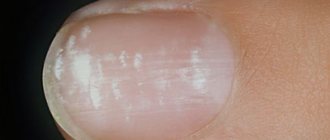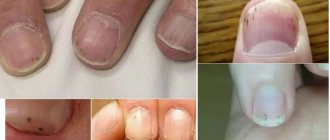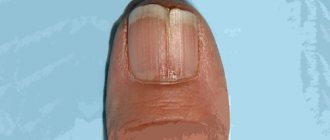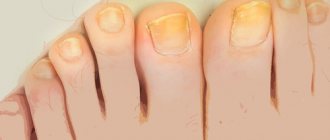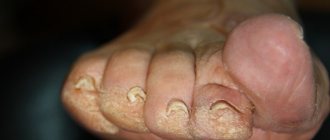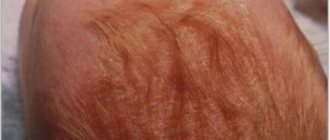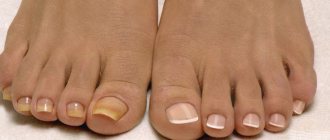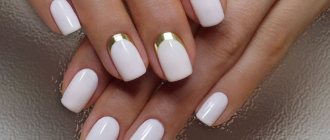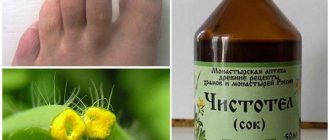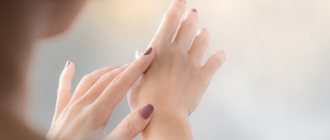Onychodystrophy is a whole group of pathologies that are accompanied by various disturbances in the shape, relief, structure or color of the nail plate and are provoked by congenital and acquired causes of an infectious or non-infectious nature. Contacting a podiatrist at our Clinic is the only correct solution to completely get rid of the existing problem. Changes bring a lot of unpleasant experiences, and treatment of onychodystrophy in children usually begins due to aesthetic discomfort experienced by the child and his parents or fear about the likely infectious origin of the disease.
Etiology
Violations in the condition of one or several nail plates in a child can be caused by various reasons:
- congenital anomalies;
- hereditary predisposition;
- chemical, biological, physical and mechanical injuries to the nails: the habit of sucking fingers or biting nails, external exposure to chemicals or high temperatures, improperly performed manicure, fungal infections, uncomfortable shoes, etc.;
- dermatological pathologies contributing to nail damage: eczema, psoriasis, alopecia, etc.;
- pathologies of the endocrine system: diabetes mellitus, thyroid dysfunction, etc.;
- lack of vitamins and minerals;
- general intoxication of the body, taking certain aggressive medications;
- stress;
- suffered serious illnesses, chronic pathologies, infections, mental disorders, neoplasms, etc.
Sometimes the development of dystrophy is provoked not by one, but by several factors at once; their determination is an important task for a podiatrist. After identifying the root causes, the specialist can eliminate the effect of negative factors and develop the most effective treatment plan with corrective manipulations to improve the appearance of the nail plates.
Clinical picture and varieties
The main symptoms of onychodystrophy in children are changes in the appearance or structure of one or more nails. Metamorphoses can be present only on one limb or one finger, on the arms and/or legs, and cover several phalanges at once. The clinical manifestations of this nail pathology are varied, as are the causes that provoke their development.
Congenital dystrophies are defined by the following terms and are manifested by the following symptoms:
- platonychia - thickening of the nail;
- koilonychia - in the central zone there is a spoon-like depression;
- micronychia - a significant decrease in the length of the nail;
- anonychia - complete or partial absence of the nail plate;
- Hippocrates' fingers - the terminal phalanges on the hands are thickened, and the nails look like convex watch glasses.
Acquired dystrophies are defined by the following names and symptoms:
- onycholysis - the plate peels off from the nail bed;
- onychorrhexis - the nail splits lengthwise;
- onychoschisis - the anterior free edge is split transversely;
- onychogryphosis - a thickened nail bends like a bird's claw;
- onychauxis - the plate becomes cloudy and darkens (even to black);
- onychoatrophy - depressions, cracks, grooves appear on the nail, it becomes thinner and completely destroyed;
- scleronychia – thickens and becomes denser;
- dyschromia - color changes in spots, stripes or completely;
- hapalonychia – softening;
- trachyonychia – the nail becomes dull and rough;
- Beau-Reilly lines – multiple transverse grooves appear in the form of arcs;
- Keller's canaliform dystrophy - a longitudinal groove appears, from which strokes extend at an angle (herringbone symptom).
Onycholysis is more often detected in childhood.
In most cases, external changes during dystrophy are not accompanied by noticeable discomfort, inflammation or pain. Such symptoms of pathology are observed only in rare cases.
Complications
Lack of proper and timely treatment of onychohistorophy in children can lead to negative consequences:
- complete or partial destruction of the nail plate;
- addition of a fungal infection;
- paronychia;
- progression of the pathology causing onychodystrophy.
In addition to these complications, the unaesthetic appearance of the affected nail causes moral distress in the child. This defect can become a reason for unpleasant jokes and statements from peers, leading to the emergence of complexes and exclusion from society.
The development of complications of onychodystrophy can only be prevented by timely contact with a podiatrist.
Purulent inflammation
An abscess on a child's finger near the nail is a common problem called paronychia. Most often, the periungual ridges and soft tissues of the fingers on the back side become inflamed. An abscess can be the result of biting nails, a torn hangnail, an ingrown nail, a wound, a scratch, a splinter getting under a child's nail, or a cut in the skin around the finger.
In a timely manner, injuries not treated with an antiseptic become an entry point for infection. Microbes present under the nails of children penetrate the skin and spread deep into the soft tissues.
Even a baby can have a sore nail. Inflammation develops due to thumb sucking, picking hangnails, or careless manicure or pedicure. The skin of babies is very thin and delicate, the immune system is poorly developed, so even an injury invisible to the mother’s eye can turn into an abscess.
If a child’s nail and finger become inflamed and festered, the baby will complain of pain that intensifies with pressure. The pain is pulsating. The skin over the abscess becomes elastic and shiny. Parents may notice that the child's finger is swollen and festering. The accumulation of pus looks like a lump or blister with a translucent yellow-green liquid.
What to do if a child’s nail breaks? First aid consists of antiseptic treatment (peroxide, furcocin).
If pus is present and the abscess increases in size, you should urgently contact a pediatric surgeon. Otherwise, the infection will spread deep down to the bones of the finger, which is very dangerous.
The doctor will clean the finger tissue from purulent contents and treat it with antiseptics and antibiotics. Prescribe dressings with age-appropriate antibacterial ointment for further home treatment.
If children have bad nails with obvious signs of pathological processes, you should not delay, but consult a doctor to make an accurate diagnosis. Nail treatment is carried out by a dermatologist, podologist, surgeon, and mycologist.
Additional information and registration by phone +7 (985) 489-45-86.
Treatment of onychodystrophy in a child
Treatment of onychodystrophy in children consists of eliminating the root causes of its development and, if necessary, taking measures to correct altered nail plates.
To draw up his tactics, the podologist prescribes the child to perform dermatoscopy, microscopy of scrapings and, in some cases, mycological culture for differential diagnosis with onychomycosis. Consultations with related specialists may also be scheduled to determine the root cause of the deformity. To treat this pathology, it is recommended to eliminate factors that injure the nail (for example, wearing comfortable shoes, stopping toe sucking, treating a chronic disease). The treatment plan may include medications, physiotherapy, orthopedic and hardware correction techniques.
The Podology Clinic in Moscow is equipped with all the necessary expert-class equipment for the diagnosis and treatment of nail pathologies. The medical center performs all necessary types of physiotherapy, therapeutic hardware cleaning, laser therapy of nail plates. In difficult cases, a child or teenager undergoes nail prosthetics using high-quality artificial plates. All procedures are performed taking into account age characteristics.
Treatment of onychodystrophy with PinPointe laser
Doctors at the Podology Clinic are the only ones in Moscow who provide laser treatment for onychodystrophy in children using the innovative PinPointe device. Nail restoration begins from the first session! The procedures are absolutely painless and stimulate the growth of a healthy nail plate without removing the affected nail or taking medications. The high efficiency of laser therapy is explained by the unique ability of the device to deliver laser beams and uniformly heat the plate tissue to a temperature of 79°. At the same time, metabolic processes are stimulated, the trophism of the nail bed is restored and a healthy nail grows without complications or side processes.
Forecast
The Blade of Podology employs experienced and tactful doctors. The center has all the necessary equipment for high-quality and accurate diagnosis of the disease, including the PinPointe micropulse laser. During the treatment process, not only modern but also innovative methods are used to speed up the recovery of patients and guarantee excellent aesthetic results.
Prevention
In some cases, the following recommendations can prevent the development of onychodystrophy:
- exclusion of traumatic factors;
- balanced diet;
- timely correction of hypovitaminosis;
- elimination of excessive sweating of the feet;
- timely treatment of flat feet;
- compliance with personal hygiene rules;
- prevention and timely treatment of chronic diseases;
- refusal to use aggressive household chemicals and cosmetics;
- correct selection of products for the care of hands, feet and nails in accordance with age;
- preventing stress and increasing stress resistance.
Don’t let the disease take its course and don’t put off visiting a specialist! Remember that nails are an indicator of overall health! The specialists of the Podology Clinic will establish trusting contact even with the smallest patient and help him acquire healthy nails in the shortest possible time. Call the clinic or make an appointment with a podiatrist using the feedback form on the website - the doctors will select an effective treatment regimen for your child.
Folk remedies
Regardless of the reason for the manifestation of such symptoms and the gradual deterioration of nails, it is recommended to pay attention to their gradual restoration in order to prevent the occurrence of complications.
Since it is not recommended to use most medications and medications to treat young children, most doctors recommend using traditional recipes that involve the use of natural, safe ingredients.
There are quite a few ways to take care of your nails at home: performing steam baths, compresses, applying lotions and others.
Steam bath
Regardless of the condition and structure of the nail bed, it is recommended to periodically take caring baths, adding auxiliary components to them.
For one of these recipes you will need:
- 40 grams of sea salt;
- 2 liters of water;
- Essential oil.
Add two tablespoons of sea salt to hot water until it dissolves, and then allow the liquid to cool to the optimal temperature. After this, add 5-7 drops of essential oil and take a bath for 15-20 minutes. There is no need to wash your feet or hands after it, just wipe it off.
Plain water is usually used as a base in baths, but it can be replaced with a decoction of medicinal herbs (plantain, celandine, burdock, chamomile, calendula), if you first brew the leaves in water for an hour and then strain.
You can also add iodine, potassium permanganate, lemon juice, soda or other useful ingredients to the baths.
Compress with aloe and onion
The recipe provides an increase in local immunity, which prevents further damage to the marigolds.
Prepare four components:
- Chopped onion – 20 grams;
- Ghee – 20 grams;
- Aloe leaf juice – 20 grams;
- Cabbage leaf.
First you need to mix the liquid ingredients and heat them in a water bath until they thicken a little. After this, the mixture is applied to the damaged fingers and a cabbage leaf is wrapped on top. The compress is fixed with a bandage and adhesive tape.
You need to make a compress at night, and in the morning remove the remains and wash your hands.
Use of oils
Essential oils quickly penetrate the structure of the nail, improving its structure and preventing the formation of delaminations, increasing local immunity.
You can use different oils:
- Tea tree;
- Sea buckthorn;
- Lavender;
- Eucalyptus;
- Rosemary;
- Mint.
The oil should be distributed over the entire surface of the nail, as well as over the cuticle area and side ridges, to further provide nutrition and saturation of the epidermis with vitamins. They should be used daily before bed.
